We all agree that our current pace of life causes us stress. That is, we feel worried, tired, and tense, and we can even develop problems such as muscle contractions or tension migraines.
Our clinical experience has led us to consider that practicing the ability to relax is essential, especially in these cases in which our body and mind are under constant tension. But many times, we ourselves do not realize how much tension we accumulate in our bodies until we find ourselves overwhelmed.
A few weeks ago we already shared with you Koeppen’s interesting relaxation techniques for the little ones in the house. Today we want to share a relaxation technique that has been scientifically proven to be effective.
How to perform a Progressive Relaxation session
In a seated or stretched position, close your eyes. Focus your attention on the sequences of muscular tension and relaxation, hold the tension for 5 seconds (inhale) and then relax the area for 10 seconds (exhale). Practice the exercise for 10-20 minutes. When all muscle groups are relaxed, focus your attention on a pleasant thought. Gradually return to your alert state, preserving the feeling of relaxation.
ARMS
Stretch out your right arm and tense it as much as you can while keeping your fist closed. Exert tension over the entire arm, from hand to shoulder. Notice the tension in the biceps, forearm, wrist, and fingers. Gradually relax and lower the arm to where you support it. Then focus on the feeling of relaxation, breathe normally, and leave the arm muscles loose, relaxed, and without tension. Notice the difference between tension and relaxation. Repeat the sequence with the left arm.
CHEST
Tighten the chest, and hold the air; try to do it as if you wanted to reduce the lungs. Notice where you feel the tension, towards the middle of the chest and at each breast. Gradually relax as you breathe out. Then focus on the feeling of relaxation, breathe normally, and leave the chest muscles loose, relaxed, and without tension. Notice the difference between tension and relaxation.
LEGS
Tense the right leg and arch the right foot back towards the knee. Exert maximum tension (glutes, thigh, knee, calf, foot). Slowly relax and return to the starting position. Then focus on the feeling of relaxation, breathe normally, and leave the leg muscles loose and relaxed. Notice the difference between tension and relaxation. Repeat the same sequence with the left leg.
FACE
Close your eyes with a lot of force. You should feel the tension in the area around the eyes. Pay special attention to the tensest areas. Relax the eye muscles slowly and return to the starting position. Then focus on the feeling of relaxation, leaving the eye muscles loose, relaxed, and without tension.
SHOULDERS
Tilt your body forward. Raise your arms, bring your elbows back and up to your back, and arch your back forward. Check where you feel tension, from the shoulders to the middle of the back. Gradually relax the muscles, pull the body back and find the starting position. Then focus on the feeling of relaxation, leaving the muscles of the shoulders and back loose, relaxed, and without tension. Notice the difference between tension and relaxation.

Tips for a good relaxation practice
Follow an orderly sequence that is always the same (starting with the hands and ending with the feet, or vice versa).
Do not worry if you forget a muscle to tense and relax. In that case, the correct thing to do is to continue with the next exercise that you remember. Even so, to avoid forgetting, it is best to review the muscles mentally before starting.
Tighten for approximately 2-5 seconds and relax the muscle, leaving it loose, as if it suddenly separated from the tendons that support it. The muscle should be kept relaxed for approximately 10-15 seconds before tensing again.
Never force the muscle excessively. The purpose of tensing is not to produce a high level of contraction, but to facilitate distension. Tensing with too much force can be harmful and can cause discomfort (special care should be taken when tensing the feet).
When relaxing, the muscle should be released suddenly, not distended slowly, as this requires greater control of the antagonist’s muscles.
Imagine in each moment the muscles that we are tensing and relaxing, especially when we relax, and feel how it continues to relax on their own after releasing it.
Concentrate on the pleasant sensation of relaxing each muscle.
Once all the muscles are relaxed, make a mental review of them. This facilitates the self-exploration of the parts that have not been able to relax properly. In this phase, it is not necessary to tense any muscle.

